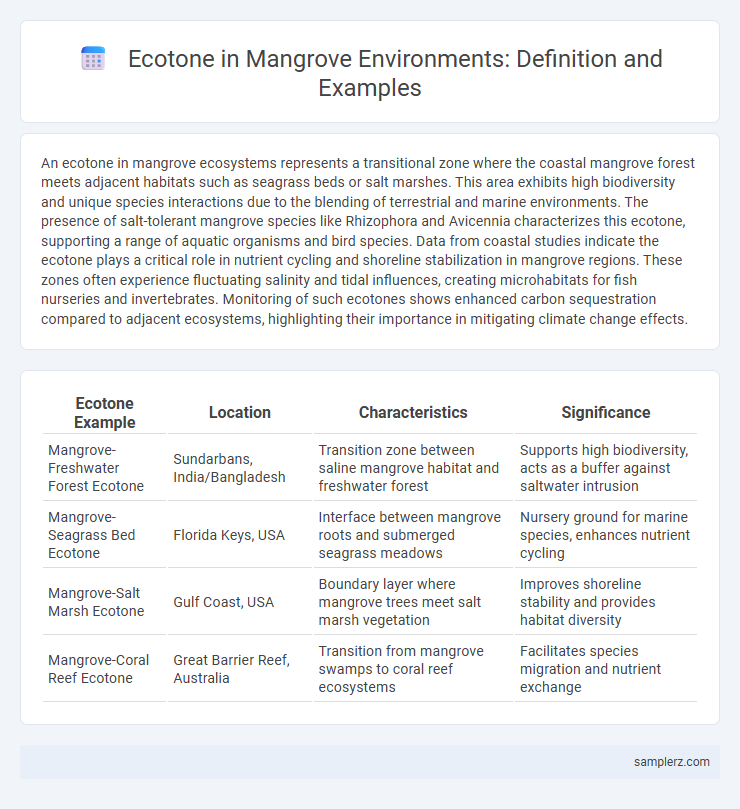An ecotone in mangrove ecosystems represents a transitional zone where the coastal mangrove forest meets adjacent habitats such as seagrass beds or salt marshes. This area exhibits high biodiversity and unique species interactions due to the blending of terrestrial and marine environments. The presence of salt-tolerant mangrove species like Rhizophora and Avicennia characterizes this ecotone, supporting a range of aquatic organisms and bird species. Data from coastal studies indicate the ecotone plays a critical role in nutrient cycling and shoreline stabilization in mangrove regions. These zones often experience fluctuating salinity and tidal influences, creating microhabitats for fish nurseries and invertebrates. Monitoring of such ecotones shows enhanced carbon sequestration compared to adjacent ecosystems, highlighting their importance in mitigating climate change effects.
Table of Comparison
| Ecotone Example | Location | Characteristics | Significance |
|---|---|---|---|
| Mangrove-Freshwater Forest Ecotone | Sundarbans, India/Bangladesh | Transition zone between saline mangrove habitat and freshwater forest | Supports high biodiversity, acts as a buffer against saltwater intrusion |
| Mangrove-Seagrass Bed Ecotone | Florida Keys, USA | Interface between mangrove roots and submerged seagrass meadows | Nursery ground for marine species, enhances nutrient cycling |
| Mangrove-Salt Marsh Ecotone | Gulf Coast, USA | Boundary layer where mangrove trees meet salt marsh vegetation | Improves shoreline stability and provides habitat diversity |
| Mangrove-Coral Reef Ecotone | Great Barrier Reef, Australia | Transition from mangrove swamps to coral reef ecosystems | Facilitates species migration and nutrient exchange |
Introduction to Mangrove Ecotones
Mangrove ecotones represent transitional zones between terrestrial and marine ecosystems, characterized by unique species diversity and dynamic environmental gradients. These areas exhibit a confluence of oxygen-rich land habitats and saline coastal waters, fostering specialized flora and fauna such as Rhizophora and Avicennia species. The ecological significance of mangrove ecotones lies in their role as buffers against coastal erosion, nurseries for fish populations, and critical carbon sinks supporting global climate regulation.
Defining Ecotones in Mangrove Ecosystems
Ecotones in mangrove ecosystems represent transitional zones where saltwater and freshwater environments converge, creating unique habitats with high biodiversity. These areas exhibit dynamic interactions between mangrove species and adjacent aquatic or terrestrial communities, resulting in gradients of salinity, nutrient availability, and soil composition. The distinct environmental conditions in mangrove ecotones support specialized flora and fauna adapted to fluctuating tides and salinity levels.
Key Characteristics of Mangrove Ecotones
Mangrove ecotones exhibit a unique blend of terrestrial and marine ecosystems, marked by fluctuating salinity levels and tidal influences that foster diverse plant and animal species. Key characteristics include intricate root systems such as prop roots and pneumatophores, which stabilize sediment and enhance nutrient cycling. These transitional zones support critical habitats for fish nurseries, bird nesting sites, and act as buffers against coastal erosion and storm surges.
Mangrove and Saltmarsh Transition Zones
Mangrove and saltmarsh transition zones exemplify ecotones where species from both ecosystems overlap, leading to high biodiversity and complex ecological interactions. These areas serve as critical buffers against coastal erosion and provide unique habitats for various fish, bird, and invertebrate species. The gradient of salinity and tidal influence in mangrove-saltmarsh ecotones enhances nutrient cycling and supports carbon sequestration, contributing to climate regulation.
Mangrove-Seagrass Ecotone Examples
The Mangrove-Seagrass ecotone is a dynamic transition zone where coastal mangrove forests interlace with underwater seagrass beds, creating a highly productive and biodiverse habitat. This ecotone supports diverse species such as juvenile fish, crustaceans, and migratory birds, enhancing nutrient cycling and shoreline stability. Key examples include the Sundarbans in South Asia and the Florida Everglades, where the interaction between mangroves and seagrasses plays a critical role in carbon sequestration and coastal resilience.
Mangrove-Freshwater Forest Boundaries
Mangrove-Freshwater Forest boundaries represent a critical ecotone characterized by the transition between salt-tolerant mangrove species and freshwater-adapted forest vegetation. This ecotonal zone exhibits unique biodiversity, including species adapted to fluctuating salinity levels and water availability. The interface plays a vital role in nutrient cycling, sediment trapping, and providing habitat connectivity crucial for coastal and inland ecosystems.
Flora Diversity in Mangrove Ecotones
Mangrove ecotones exhibit high flora diversity, where salt-tolerant species like Rhizophora, Avicennia, and Sonneratia coexist with freshwater plants such as ferns and orchids. These transitional zones support unique plant communities adapted to fluctuating salinity, tidal inundation, and nutrient availability. The diverse vegetation structure enhances habitat complexity, promoting ecological resilience and productivity in coastal ecosystems.
Fauna Adaptation in Mangrove Ecotones
Mangrove ecotones exhibit unique fauna adaptations where species such as mudskippers and fiddler crabs demonstrate specialized behaviors to thrive in fluctuating tidal zones. These organisms have evolved physiological traits like salt excretion and amphibious mobility to navigate the brackish water and shifting substrates. Such adaptations enhance biodiversity and ecological resilience within mangrove transition zones.
Ecological Functions of Mangrove Ecotones
Mangrove ecotones, where coastal forests meet tidal waters, serve crucial ecological functions by providing transitional habitats that support high biodiversity and nursery grounds for marine species. These areas facilitate nutrient cycling between terrestrial and aquatic ecosystems and act as buffers against coastal erosion and storm surges. The complex root systems within mangrove ecotones also enhance water filtration and carbon sequestration, contributing significantly to coastal ecosystem resilience.
Conservation Strategies for Mangrove Ecotones
Mangrove ecotones, where saltwater and freshwater ecosystems intersect, require targeted conservation strategies such as creating protected buffer zones to preserve biodiversity and prevent habitat fragmentation. Restoring degraded mangrove areas through reforestation and monitoring salinity levels helps maintain the delicate balance essential for these transitional habitats. Sustainable management practices, including community engagement and regulating coastal development, enhance resilience against climate change impacts in mangrove ecotones.

example of ecotone in mangrove Infographic
 samplerz.com
samplerz.com